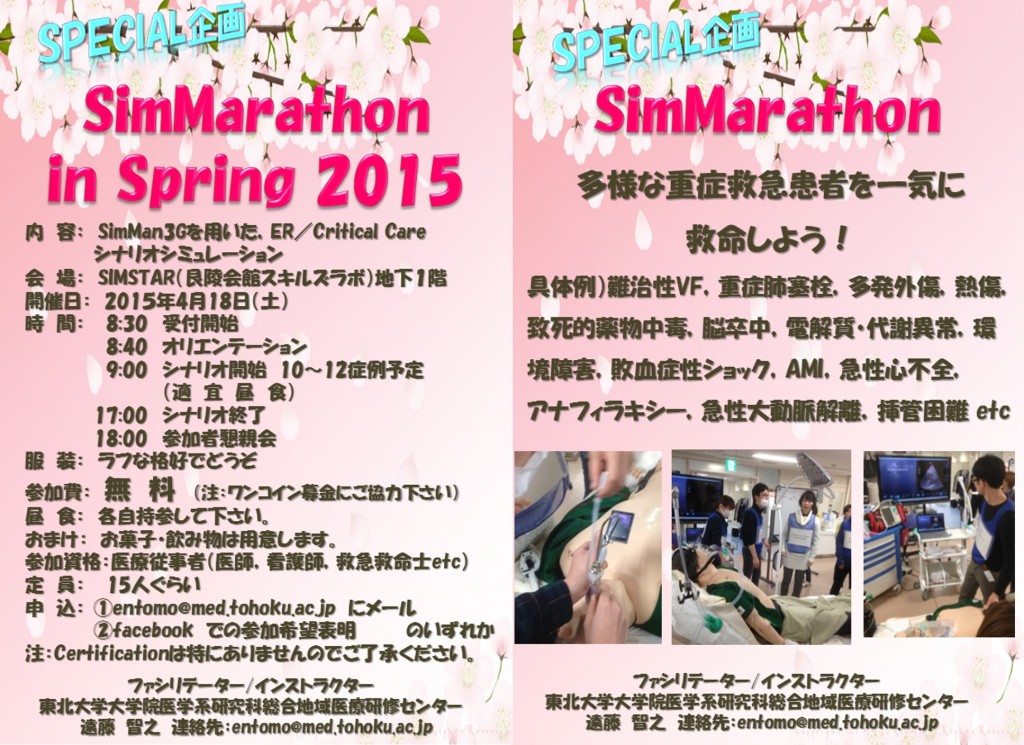I want to introduce the outline and rules of my special simulation seminar named “SimMarathon”
Registration 8:30~8:45
Start time 9:00 ~ Finish time 17:00
Outline and Rules
- You can freely eat and drink some prepared cakes and drinks.
- Please donate a little bit after the entire simulation. Neither upper nor lower limit.
- Your name card is also the certificate of attendance.
- This Sim room is supposed to be a tertiary emergency room of general hospital. We have to accept all of the patients who is coming regardless of the severity and type of illness. In this Sim room, most of all kinds of examinations and treatments such as ultrasound, radiology (Portable X-ray, CT and MRI), laboratory tests(CBC, Chemistry and Coagulation), blood transfusion, NPPV, mechanical ventilation and ECMO therapy are available 24-7.
- If ECMO therapy is required, your team is supposed to start ECMO procedures such as priming, cannulation and pump-on with a water-drill circuit.
- Time management will be based on the special clock prepared for simulation.
- All patients brought into ER are supposed to be seriously ill or injured in general.
- The goal of each scenario is to evaluate the patient condition thoroughly and give appropriate interventions timely and then get stability before ICU admission.
- Regardless of career, each trainee is supposed to be in charge of one scenario as a team leader. Other team members will put on bibs for various kinds of roles.
- The recorder who is in charge of writing down the medical chart on white board will be changed every time.
- The team leader should be focused on gathering patient information, analyzing patient diagnosis and giving proper orders to the other team members.
- The constructive intervention or advice from other team members will be fully allowed.
- Please guess the differential diagnosis based on the prehospital information before the patient arrives in ER.
- You have to deal with the simulator as if it were a real patient. The simulator’s condition such as eye opening, pupils (size and light reflex), airway difficulty, respiratory sounds, heart sounds, and pulsatility of each pulse are set like a real patient as far as possible.
- Some physical findings such as jugular vein distention, skin lesion, legs edema will be shared by photos taken by real patients.
- Patient history will be summarized and shared as AMPLE.
- When team leader gives orders related to drug injection or fluid administration, the leader should tell the kind of fluid, IV access site, size of catheter, IV volume and speed in detail. If micro-infusion is required, the precise speed like μg/kg/min should be determined.
- 12 leads ECG will be shown right after each electrode has attached to simulator.
- Blood gas analysis data will be shown one or two minutes later.
- Portable X-ray findings will be shown right after taking them.
- When you want to use defibrillator pads for defibrillation or TCP, use the alternative connector made for this purpose.
- Video-assisted laryngoscopes such as MacGRATH and AirwayScope are available. DAM cart is also available. You can use whatever you want to use.
- If CT study is needed, the team has to move the patient to simulated CT room next to the ER.
- The rest of the trainees might be responsible for some extra roles such as patient’s family member, radiology specialist and laboratory specialist.
- Each scenario contains mini-lecture, which will be done with debriefing.
- You can use your own smartphone or tablet or computer or whatever you can access on internet.
- You can refer any kinds of books or texts you want to search with.
- You can use WiFi of this room.
- We won’t have lunch break. You have to take some break respectively.
- SimMarathon will be ended at 5 pm.
- Please write the evaluation form after this seminar.
